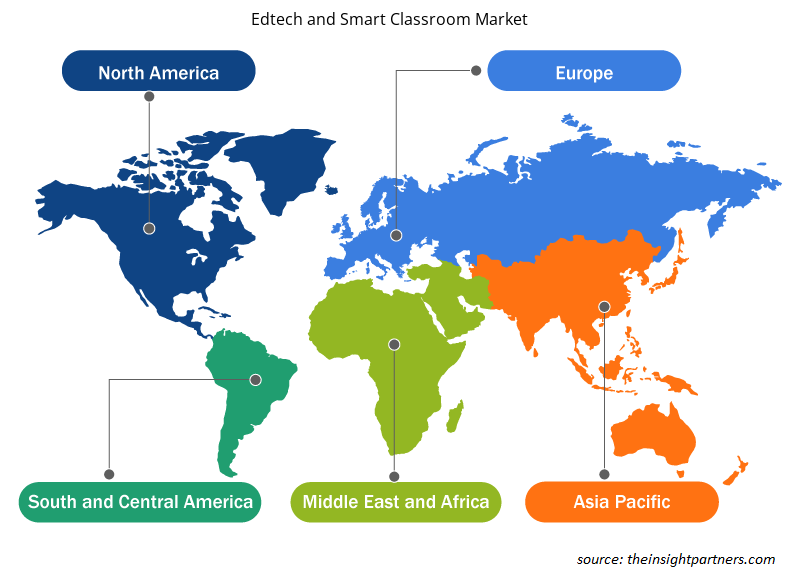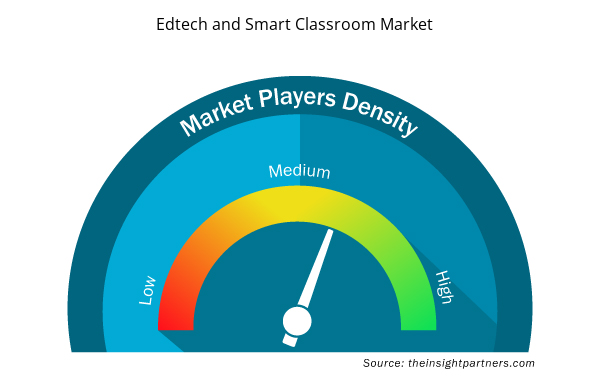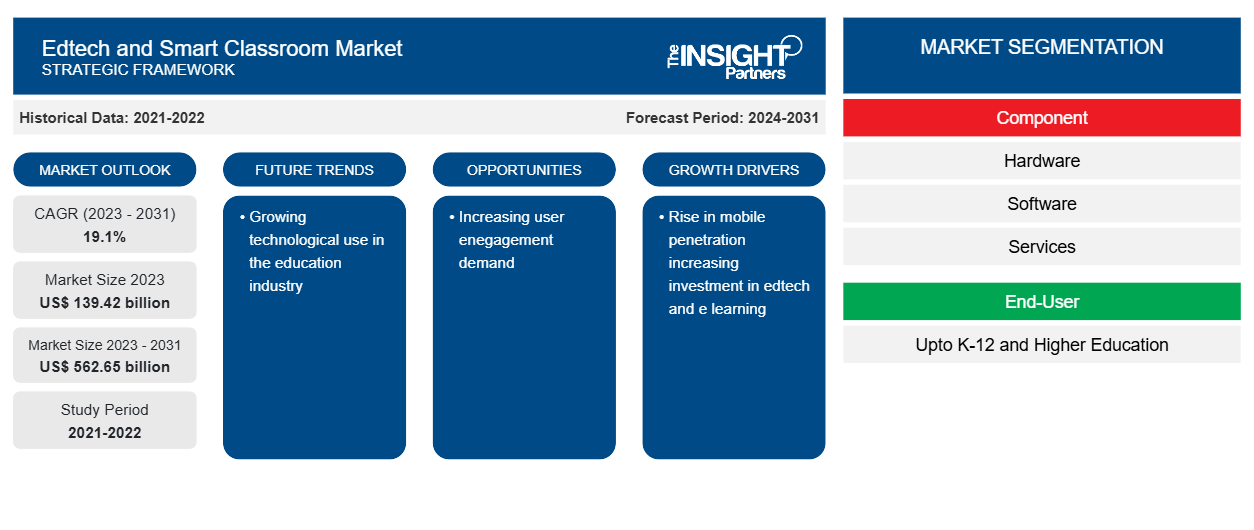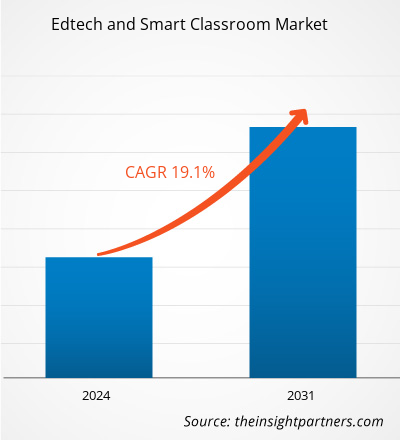Der Edtech- und Smart-Classroom-Markt soll von 139,42 Milliarden US-Dollar im Jahr 2023 auf 562,65 Milliarden US-Dollar im Jahr 2031 wachsen; von 2023 bis 2031 wird eine durchschnittliche jährliche Wachstumsrate von 19,1 % erwartet. Der zunehmende Einsatz von Technologie in der Bildungsbranche wird voraussichtlich weiterhin ein wichtiger Edtech- und Smart-Classroom-Markttrend bleiben.
Edtech- und Smart Classroom-Marktanalyse
IT-Systeme, insbesondere Cloud-basierte Plattformen, sind aufgrund der zunehmenden Bedeutung digitaler Unterrichtsplanung und Fernunterricht wichtiger denn je. Die Cloud ist möglicherweise eine technologische Innovation, die ihren Benutzern eine Transformation ermöglicht. Durch die Verwendung von entfernten Servern, Netzwerken, Datenbanksystemen, Analysen, Speichersystemen , Software und anderen digitalen Ressourcen ist Cloud Computing ein Paradigma der Informationstechnologie, das Computerdienste über das Internet bereitstellt. Für die Hochschulbildung bietet Cloud Computing erhebliche Vorteile, insbesondere für Schüler der Klassen K-12. Pädagogen können mühelos virtuellen Unterricht abhalten und ihre Schüler in verschiedene Online-Aufgaben und -Programme einbeziehen, indem sie Cloud Computing im Klassenzimmer nutzen. Die zunehmende Nutzung von virtuellem Unterricht treibt also das Wachstum des Edtech- und Smart-Classroom-Marktes voran.
Edtech- und Smart Classroom-Marktübersicht
Die Cloud ist die am weitesten verbreitete Technologie, da sie anpassbare Speicher- und Nutzungsmöglichkeiten, starke Sicherheitsfunktionen und eine einfache Handhabung bietet. Pädagogen können die Cloud für kostengünstiges Online-Lernen, Filesharing und die Speicherung großer Dateien in einer Vielzahl von Formaten nutzen. Aus diesem Grund bevorzugen fast alle EdTech-Unternehmen und Bildungseinrichtungen die Nutzung der Cloud. Lernen durch Gamification ist ein weiterer kreativer Trend. Was Bildungstechnologie betrifft , sind herkömmliche Bildungsmethoden mühsam und erfordern intensive Konzentration auf Gamification; sie machen das Lernen jedoch zu einem unterhaltsamen Unterfangen. Durch Gamification können Schüler mit einem Timer oder miteinander konkurrieren, ihren Fortschritt in Echtzeit auf Bestenlisten verfolgen und Preise für hohe Punktzahlen erhalten. Für die heutigen Benutzer hat dies die Spannung und den Spaß am Lernen erhöht. Viele bedeutende Firmen haben Gamification als Marketingtrend als Reaktion auf diesen EdTech- und Smart-Classroom-Trend eingesetzt.
Passen Sie diesen Bericht Ihren Anforderungen an
Sie erhalten kostenlos individuelle Anpassungen an jedem Bericht, einschließlich Teilen dieses Berichts oder einer Analyse auf Länderebene, eines Excel-Datenpakets sowie tolle Angebote und Rabatte für Start-ups und Universitäten.
- Holen Sie sich die wichtigsten Markttrends aus diesem Bericht.Dieses KOSTENLOSE Beispiel umfasst eine Datenanalyse von Markttrends bis hin zu Schätzungen und Prognosen.
Treiber und Chancen auf dem Edtech- und Smart Classroom-Markt and Smart Classroom Market Drivers and Opportunities
Steigende Verbreitung mobiler Geräte fördert Marktwachstum
Die Verbreitung von Mobiltelefonen ist bei Menschen mit niedrigem Einkommen am höchsten. Laut Saperstein hat AT&T 100 Millionen US-Dollar angeboten, um 50.000 Studenten in einkommensschwachen und ländlichen Gegenden mit Mobilfunk und Geräten auszustatten. Indien, mit 18 Milliarden Einwohnern das zweitbevölkerungsreichste Land der Welt (Weltbank), könnte China bis 2024 überholen und das bevölkerungsreichste Land werden (UN-Bericht).Saperstein. India, the world's second most populous country, with 18 billion people (World Bank), may overtake China to become the most populated country by 2024 (UN Report).
Darüber hinaus hat Indien eine der jüngsten Bevölkerungen: Fast 30 % der indischen Bevölkerung sind zwischen 18 und 34 Jahre alt und 260 Millionen Schulkinder. Laut dem Bericht von Project Tomorrow verfügen im Jahr 2022 33 % der US-amerikanischen Highschool-Schüler und 31 % der Mittel- und Grundschüler über von der Schule bereitgestellte Mobilgeräte. Aufgrund der weit verbreiteten Nutzung mobiler Geräte sind Gamification , virtuelle Klassenzimmer und E-Learning auf dem Vormarsch, was das Wachstum des Edtech- und Smart-Classroom-Marktes vorantreibt.edtech and smart classroom market.
Edtech- und Smart Classroom-Marktbericht – Segmentierungsanalyse
Wichtige Segmente, die zur Ableitung der Edtech- und Smart Classroom-Marktanalyse beigetragen haben, sind die Komponenten- und Endbenutzer
- Basierend auf den Komponenten ist der Edtech- und Smart-Classroom-Markt in Hardware, Software und Dienstleistungen segmentiert.
- Basierend auf den Endbenutzern ist der Edtech- und Smart-Classroom-Markt in die Klassen K-12 und Hochschulbildung segmentiert.
Edtech- und Smart Classroom-Marktanteilsanalyse nach geografischer Lage
- Der Edtech- und Smart-Classroom-Markt ist in fünf große Regionen unterteilt: Nordamerika, Europa, Asien-Pazifik (APAC), Naher Osten und Afrika (MEA) sowie Süd- und Mittelamerika. Der Asien-Pazifik-Raum wird im Prognosezeitraum voraussichtlich die höchste durchschnittliche jährliche Wachstumsrate aufweisen.
- China hat in den letzten Jahren beträchtliche Investitionen in IKT-Infrastruktur und Bildungsressourcen getätigt, was die Integration von Technologie in die Bildung vorangetrieben hat. In China hat Online-Lernen in den letzten Jahren an Popularität gewonnen. E-Learning-Nutzer werden immer häufiger. Beispielsweise bietet die Region eine Reihe von E-Learning-Systemen an, darunter Online-Lernen, VIPKid und eine Bildungsplattform, die chinesischen Kindern im Alter zwischen 4 und 15 Jahren Einzelunterricht in Englisch bietet. Seit den 1990er Jahren, als E-Learning erstmals aufkam, hat die Regierung aufgrund der Umsetzung vieler Richtlinien großen Wert auf seine Entwicklung gelegt. Infolgedessen hat die Region im Bereich E-Learning viel erreicht, was das Wachstum des Edtech- und Smart-Classroom-Marktes vorantreibt.
Regionale Einblicke in den Edtech- und Smart Classroom-Markt
Die regionalen Trends und Faktoren, die den Edtech- und Smart Classroom-Markt während des Prognosezeitraums beeinflussen, wurden von den Analysten von Insight Partners ausführlich erläutert. In diesem Abschnitt werden auch Edtech- und Smart Classroom-Marktsegmente und die Geografie in Nordamerika, Europa, im asiatisch-pazifischen Raum, im Nahen Osten und Afrika sowie in Süd- und Mittelamerika erörtert.

- Holen Sie sich regionale Daten zum Edtech- und Smart Classroom-Markt
Umfang des Edtech- und Smart Classroom-Marktberichts
| Berichtsattribut | Details |
|---|---|
| Marktgröße im Jahr 2023 | 139,42 Milliarden US-Dollar |
| Marktgröße bis 2031 | 562,65 Milliarden US-Dollar |
| Globale CAGR (2023 - 2031) | 19,1 % |
| Historische Daten | 2021-2022 |
| Prognosezeitraum | 2024–2031 |
| Abgedeckte Segmente | Nach Komponente
|
| Abgedeckte Regionen und Länder | Nordamerika
|
| Marktführer und wichtige Unternehmensprofile |
|
Marktteilnehmerdichte: Der Einfluss auf die Geschäftsdynamik
Der Edtech- und Smart Classroom-Markt wächst rasant, angetrieben von der steigenden Nachfrage der Endnutzer aufgrund von Faktoren wie sich entwickelnden Verbraucherpräferenzen, technologischen Fortschritten und einem größeren Bewusstsein für die Vorteile des Produkts. Mit steigender Nachfrage erweitern Unternehmen ihr Angebot, entwickeln Innovationen, um die Bedürfnisse der Verbraucher zu erfüllen, und nutzen neue Trends, was das Marktwachstum weiter ankurbelt.
Die Marktteilnehmerdichte bezieht sich auf die Verteilung von Firmen oder Unternehmen, die in einem bestimmten Markt oder einer bestimmten Branche tätig sind. Sie gibt an, wie viele Wettbewerber (Marktteilnehmer) in einem bestimmten Marktraum im Verhältnis zu seiner Größe oder seinem gesamten Marktwert präsent sind.
Die wichtigsten Unternehmen auf dem Edtech- und Smart Classroom-Markt sind:
- Apple Inc.
- Blackboard Inc.
- Cisco Systems, Inc.
- D2L-Unternehmen
- IBM Corporation
- Lenovo-Gruppe Limited
Haftungsausschluss : Die oben aufgeführten Unternehmen sind nicht in einer bestimmten Reihenfolge aufgeführt.

- Überblick über die wichtigsten Akteure auf dem Edtech- und Smart Classroom-Markt
Edtech- und Smart Classroom-Marktnachrichten und aktuelle Entwicklungen
Der Peer-to-Peer-Versicherungsmarkt wird durch die Erhebung qualitativer und quantitativer Daten nach Primär- und Sekundärforschung bewertet, die wichtige Unternehmensveröffentlichungen, Verbandsdaten und Datenbanken umfasst. Im Folgenden finden Sie eine Liste der Entwicklungen auf dem Edtech- und Smart-Classroom-Markt:
- Im Juli 2022 kündigte Blackboard Inc. die Veröffentlichung der Reporting Tier für die Blackboard Data-Plattform an, die Institutionen Berichte zur Verfügung stellt, die Aufschluss über die Nutzung von Lerntools innerhalb des Blackboard SaaS EdTech-Ökosystems geben.
(Quelle: Blackboard Inc, Pressemitteilung)
- Im September 2022 hat Cisco Webex Classrooms eingeführt, die Lehrer, Schüler und Eltern unabhängig von ihrem physischen Standort sicher in einem einzigen Bereich verbinden.
(Quelle: Cisco, Pressemitteilung)
Edtech- und Smart Classroom-Marktbericht – Abdeckung und Ergebnisse
Die „Marktgröße und Prognose für Edtech und Smart Classroom (2021-2031)“ bietet eine detaillierte Analyse des Marktes, die die unten genannten Bereiche abdeckt:
- Marktgröße und Prognose auf globaler, regionaler und Länderebene für alle wichtigen Marktsegmente, die im Rahmen des Projekts abgedeckt sind
- Marktdynamik wie Treiber, Beschränkungen und wichtige Chancen
- Wichtige Zukunftstrends
- Detaillierte PEST/Porters Five Forces- und SWOT-Analyse
- Globale und regionale Marktanalyse mit wichtigen Markttrends, wichtigen Akteuren, Vorschriften und aktuellen Marktentwicklungen
- Branchenlandschaft und Wettbewerbsanalyse, einschließlich Marktkonzentration, Heatmap-Analyse, prominenten Akteuren und aktuellen Entwicklungen
- Detaillierte Firmenprofile
- Historische Analyse (2 Jahre), Basisjahr, Prognose (7 Jahre) mit CAGR
- PEST- und SWOT-Analyse
- Marktgröße Wert/Volumen – Global, Regional, Land
- Branche und Wettbewerbsumfeld
- Excel-Datensatz



Report Coverage
Revenue forecast, Company Analysis, Industry landscape, Growth factors, and Trends

Segment Covered
This text is related
to segments covered.

Regional Scope
North America, Europe, Asia Pacific, Middle East & Africa, South & Central America

Country Scope
This text is related
to country scope.
Häufig gestellte Fragen
North America is expected to hold the highest market share in the edtech and smart classroom market.
Growing technological use in the education industry is anticipated to play a significant role in the global edtech and smart classroom market in the coming years.
The key players holding majority shares in the global edtech and smart classroom market are Blackboard Inc., Cisco Systems, Inc., IBM Corporation, Microsoft Corporation, and Oracle Corporation.
The rise in mobile penetration and increasing investment in edtech and e-learning are the major factors driving the edtech and smart classroom market.
The global edtech and smart classroom market was estimated to be US$ 139.42 billion in 2023 and is expected to grow at a CAGR of 19.1% during the forecast period 2024 - 2031.
Trends and growth analysis reports related to Technology, Media and Telecommunications : READ MORE..
The Insight Partners performs research in 4 major stages: Data Collection & Secondary Research, Primary Research, Data Analysis and Data Triangulation & Final Review.
- Data Collection and Secondary Research:
As a market research and consulting firm operating from a decade, we have published and advised several client across the globe. First step for any study will start with an assessment of currently available data and insights from existing reports. Further, historical and current market information is collected from Investor Presentations, Annual Reports, SEC Filings, etc., and other information related to company’s performance and market positioning are gathered from Paid Databases (Factiva, Hoovers, and Reuters) and various other publications available in public domain.
Several associations trade associates, technical forums, institutes, societies and organization are accessed to gain technical as well as market related insights through their publications such as research papers, blogs and press releases related to the studies are referred to get cues about the market. Further, white papers, journals, magazines, and other news articles published in last 3 years are scrutinized and analyzed to understand the current market trends.
- Primary Research:
The primarily interview analysis comprise of data obtained from industry participants interview and answers to survey questions gathered by in-house primary team.
For primary research, interviews are conducted with industry experts/CEOs/Marketing Managers/VPs/Subject Matter Experts from both demand and supply side to get a 360-degree view of the market. The primary team conducts several interviews based on the complexity of the markets to understand the various market trends and dynamics which makes research more credible and precise.
A typical research interview fulfils the following functions:
- Provides first-hand information on the market size, market trends, growth trends, competitive landscape, and outlook
- Validates and strengthens in-house secondary research findings
- Develops the analysis team’s expertise and market understanding
Primary research involves email interactions and telephone interviews for each market, category, segment, and sub-segment across geographies. The participants who typically take part in such a process include, but are not limited to:
- Industry participants: VPs, business development managers, market intelligence managers and national sales managers
- Outside experts: Valuation experts, research analysts and key opinion leaders specializing in the electronics and semiconductor industry.
Below is the breakup of our primary respondents by company, designation, and region:

Once we receive the confirmation from primary research sources or primary respondents, we finalize the base year market estimation and forecast the data as per the macroeconomic and microeconomic factors assessed during data collection.
- Data Analysis:
Once data is validated through both secondary as well as primary respondents, we finalize the market estimations by hypothesis formulation and factor analysis at regional and country level.
- Macro-Economic Factor Analysis:
We analyse macroeconomic indicators such the gross domestic product (GDP), increase in the demand for goods and services across industries, technological advancement, regional economic growth, governmental policies, the influence of COVID-19, PEST analysis, and other aspects. This analysis aids in setting benchmarks for various nations/regions and approximating market splits. Additionally, the general trend of the aforementioned components aid in determining the market's development possibilities.
- Country Level Data:
Various factors that are especially aligned to the country are taken into account to determine the market size for a certain area and country, including the presence of vendors, such as headquarters and offices, the country's GDP, demand patterns, and industry growth. To comprehend the market dynamics for the nation, a number of growth variables, inhibitors, application areas, and current market trends are researched. The aforementioned elements aid in determining the country's overall market's growth potential.
- Company Profile:
The “Table of Contents” is formulated by listing and analyzing more than 25 - 30 companies operating in the market ecosystem across geographies. However, we profile only 10 companies as a standard practice in our syndicate reports. These 10 companies comprise leading, emerging, and regional players. Nonetheless, our analysis is not restricted to the 10 listed companies, we also analyze other companies present in the market to develop a holistic view and understand the prevailing trends. The “Company Profiles” section in the report covers key facts, business description, products & services, financial information, SWOT analysis, and key developments. The financial information presented is extracted from the annual reports and official documents of the publicly listed companies. Upon collecting the information for the sections of respective companies, we verify them via various primary sources and then compile the data in respective company profiles. The company level information helps us in deriving the base number as well as in forecasting the market size.
- Developing Base Number:
Aggregation of sales statistics (2020-2022) and macro-economic factor, and other secondary and primary research insights are utilized to arrive at base number and related market shares for 2022. The data gaps are identified in this step and relevant market data is analyzed, collected from paid primary interviews or databases. On finalizing the base year market size, forecasts are developed on the basis of macro-economic, industry and market growth factors and company level analysis.
- Data Triangulation and Final Review:
The market findings and base year market size calculations are validated from supply as well as demand side. Demand side validations are based on macro-economic factor analysis and benchmarks for respective regions and countries. In case of supply side validations, revenues of major companies are estimated (in case not available) based on industry benchmark, approximate number of employees, product portfolio, and primary interviews revenues are gathered. Further revenue from target product/service segment is assessed to avoid overshooting of market statistics. In case of heavy deviations between supply and demand side values, all thes steps are repeated to achieve synchronization.
We follow an iterative model, wherein we share our research findings with Subject Matter Experts (SME’s) and Key Opinion Leaders (KOLs) until consensus view of the market is not formulated – this model negates any drastic deviation in the opinions of experts. Only validated and universally acceptable research findings are quoted in our reports.
We have important check points that we use to validate our research findings – which we call – data triangulation, where we validate the information, we generate from secondary sources with primary interviews and then we re-validate with our internal data bases and Subject matter experts. This comprehensive model enables us to deliver high quality, reliable data in shortest possible time.


 Holen Sie sich ein kostenloses Muster für diesen Bericht
Holen Sie sich ein kostenloses Muster für diesen Bericht